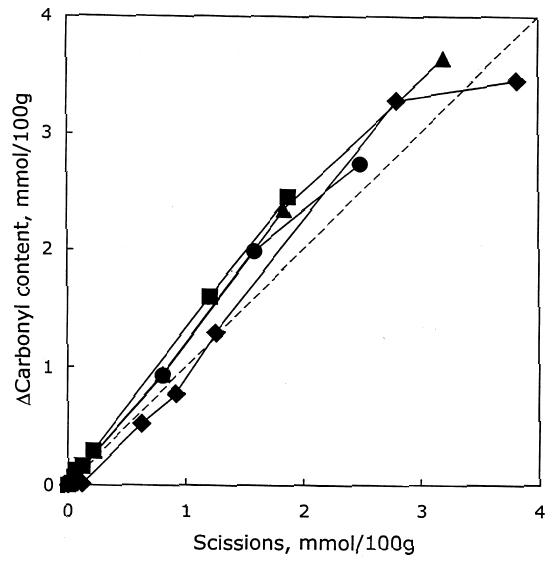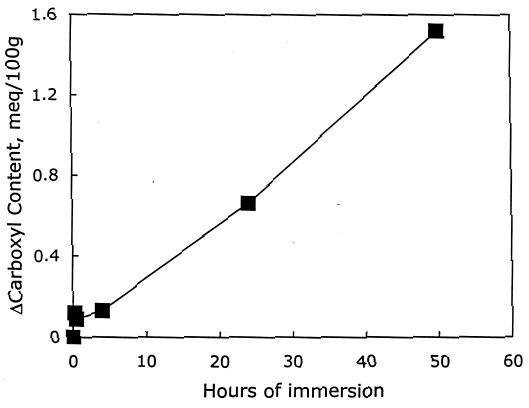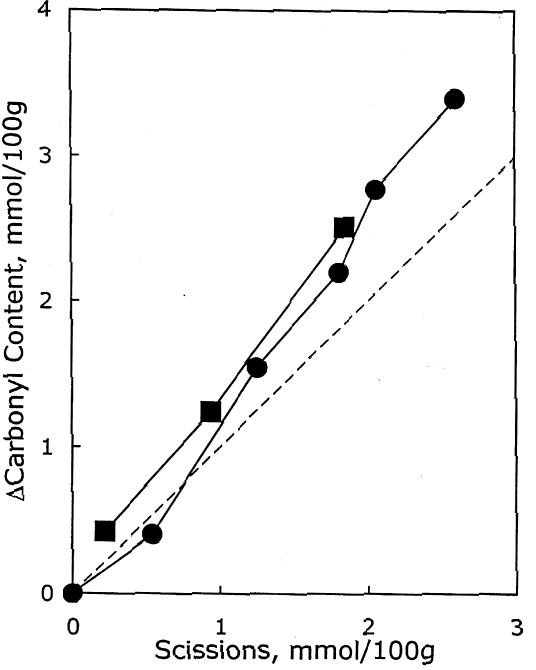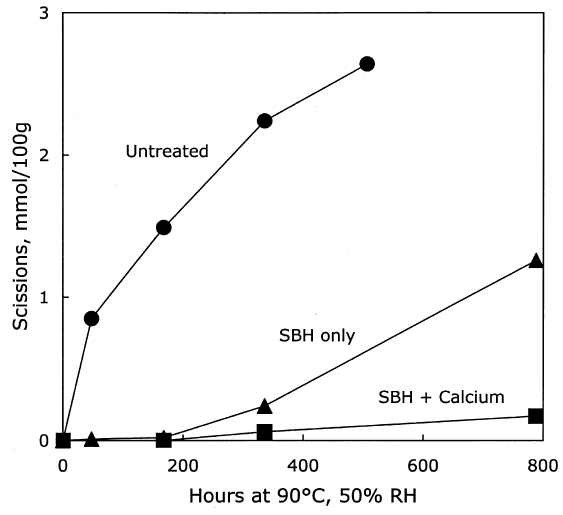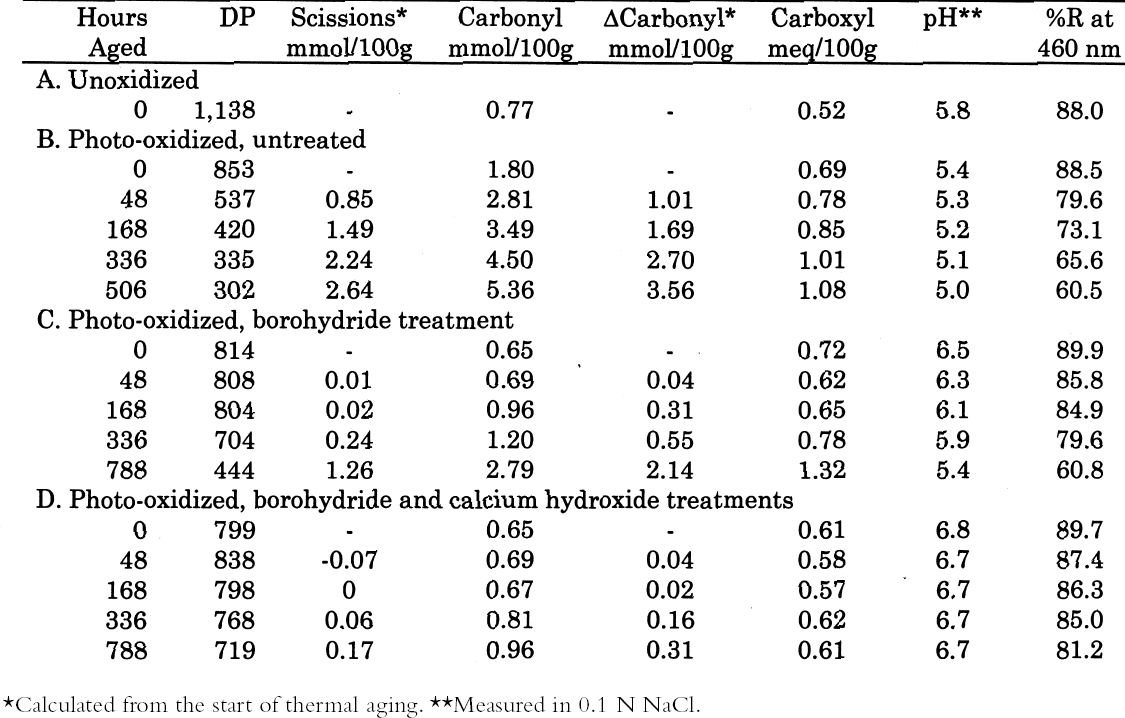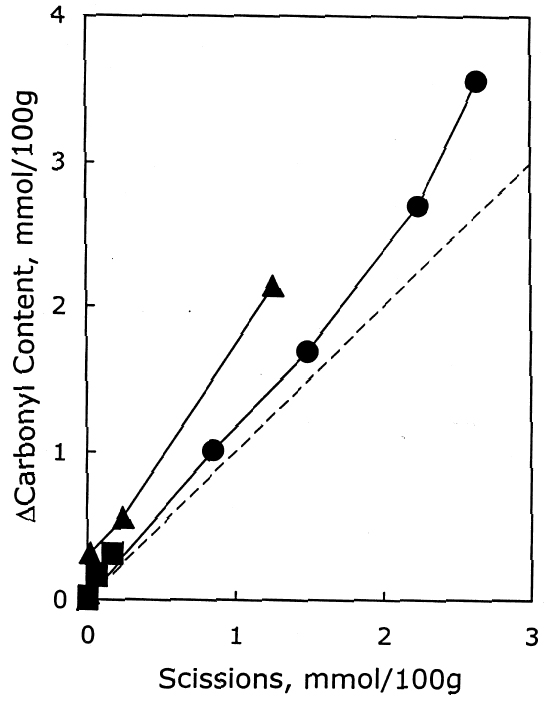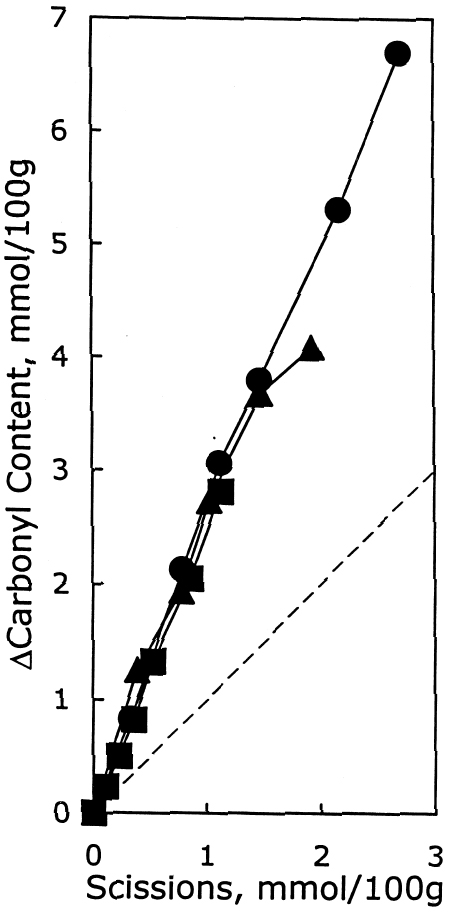EFFECTS OF DILUTE CALCIUM WASHING TREATMENTS ON PAPERJOHN BOGAARD, & PAUL M. WHITMORE
ABSTRACT—Dilute aqueous solutions of three different calcium salts have been compared for their effectiveness as wash treatments for stabilizing the cellulose of paper objects. Treated paper samples were evaluated for chemical changes resulting from the treatment and from subsequent accelerated thermal aging. The extent of alkaline damage of the treated sheets was found to be insignificant even for photo-oxidized papers. The treatments slowed the deterioration of the paper during thermal aging, but eventually the protective benefit weakened. Neutralization of acid in the sheets had a greater stabilizing effect on the paper than did the presence of calcium. Dilute alkaline calcium washes were less effective in retarding degradation of photo-oxidized papers than the same washes of unoxidized sheets. Chemical reduction of the photo-oxidized paper followed by washing with the dilute alkaline calcium solution was very effective at slowing its deterioration during thermal aging. Treatment with the dilute alkaline calcium solution also slowed photo-oxidation of paper during exposure to near-ultraviolet radiation. TITRE—Les effets sur le papier du lavage en solution � faible concentration de calcium. R�SUM�— Des solutions aqueuses � faible concentration de trois diff�rents sels de calcium ont �t� choisies pour comparer leur efficacit� comme traitements de lavage et de stabilisation de la cellulose des objets en papier. Des �chantillons de papier ainsi trait�s ont �t� �valu�s pour d�terminer les changements chimiques r�sultant du traitement, ainsi que leur r�action lors de tests de vieillissement thermique acc�l�r�. L'ampleur des dommages caus�s pas ces solutions alkalines sur les feuilles trait�es s'est av�r�e insignifiante, m�me pour les papiers d�j� oxyd�s par la lumi�re. Les traitements ont ralenti la d�t�rioration du papier pendant le vieillissement thermique, mais par la suite l'effet protecteur a diminu�. La neutralisation de l'acide dans les feuilles a eu un plus grand effet stabilisateur sur le papier que la pr�sence du calcium. Les lavages en solutions alkalines � faible concentration de calcium furent moins efficaces pour retarder la d�gradation des papiers d�j� oxyd�s par la lumi�re que les m�mes lavages sur des feuilles non oxyd�es. La r�duction chimique du papier oxyd� par la lumi�re, suivie du lavage avec la solution alkaline � faible concentration de calcium, fut tr�s effective pour ralentir la d�t�rioration de ce papier pendant le vieillissement thermique. Le traitement avec la solution alkaline � faible concentration de calcium a �galement ralenti l'oxydation du papier lors d'exposition aux rayons ultraviolets voisins du spectre visible. TITULO—El efecto sobre papel del tratamiento por medio de ba�os con soluci�n diluida de calcio. RESUMEN—Las soluciones acuosas diluidas de tres sales de calcio diferentes que fueron utilizadas en tratamientos de ba�os han sido comparadas por su efectividad en la estabilizaci�n de la celulosa en objetos de papel. Las muestras de papel tratadas fueron evaluadas observando los cambios qu�micos que ocurrieron como resultados del tratamiento y de haber sido sometidas a envejecimiento t�rmico acelerado. Se encontr� que el da�o por alcalinidad en las muestras tratadas es insignificante, aun en los papeles foto-oxidados. Los tratamientos demoraron el deterioro del papel durante la prueba de envejecimiento t�rmico, pero eventualmente el beneficio protector disminuy�. La neutralizaci�n del �cido en el papel tuvo un efecto de estabilizaci�n mayor que la presencia del calcio. Los ba�os alcalinos de calcio diluido fueron menos efectivos para retardar la degradaci�n de los papeles foto-oxidados que los mismos ba�os en muestras no oxidadas. Le reducci�n qu�mica de los papeles foto-oxidados, seguida de un ba�o con la soluci�n alcalina de calcio diluido fue muy efectiva para disminuir el deterioro durante el envejecimiento t�rmico. El tratamiento con una soluci�n alcalina de calcio diluido, tambi�n disminuy� la foto-oxidaci�n del papel durante la exposici�n a radiaci�n cercana al espectro ultravioleta. 1 INTRODUCTIONConservation treatments of individual paper artifacts, Although this enrichment of the wash water with calcium is generally accepted as beneficial, there is still some uncertainty as to which calcium salt and what strength of solution are appropriate in different situations (Burgess 1986). Most papers requiring treatment are acidic and thus subject to degradation by hydrolysis reactions that can be prevented by an alkaline wash treatment. However, papers that have been oxidized by light exposure or bleaching treatments may also be susceptible to alkaline damage during such a treatment and in subsequent aging. Assessing and minimizing these two risks are necessary for the design of the most effective treatment for each object. The subject of washing or deacidifying using aqueous solutions of calcium compounds has been examined for many years beginning with work by Barrow (Barrow and Sproull 1959), in which he suggested using successive solutions of calcium hydroxide and calcium bicarbonate. Subsequent work has examined the effects of calcium treatments on different types of paper (Hey 1979; Burgess and Boronyak-Szaplonczay 1992) or the use of different concentrations of calcium (Tang 1981). Studies have also been made that compare calcium and magnesium treatments (Calvini et al. 1988; Kolar and Novak 1996; Bansa 1998). Schaeffer et al. (1996) examined the use of calcium and magnesium solutions in aqueous light bleaching. Lienardy and Van Damme (1990) looked at the effects of various deacidification agents on the inks and pigments found on paper. In general, these studies evaluated papers using measures such as pH, brightness, and folding endurance, before and after a set period of aging, but they did not examine the chemical details of these treatments. They generally support the notion that alkaline calcium treatments are effective at stabilizing cellulose in papers, but the choice of calcium salt solution, concentration, and treatment times are still left to the conservator. The work described in this article explores the relative stabilizing effects on paper of a number of calcium salts applied as dilute aqueous solutions. Chemical measurements were made in order to examine the interactions of these solutions with cellulose and to quantify small amounts of damage and deterioration before they would be manifest as a loss in physical properties. Accelerated aging of the sample sheets was performed so that long-term effects of these treatments could be distinguished. Of special interest was studying the extent of problems associated with the use of alkaline treatments on oxidized papers. The salt concentrations used are probably closer to ones employed in a conservation washing step than to those employed in a deacidification treatment. Solutions of a variety of calcium salts were used to separate the effects due to the calcium itself from those due to the alkalinity. To examine the interactions of the calcium solutions with cellulose alone, tests were run on a pure cellulose filter paper—Whatman no. 42, which is unsized and free of the additives found in commercial papers. This paper is made from cotton linters and is slightly acidic due to its carboxylic acid content. The effects of the treatment on both unaged and photo-oxidized paper sheets were studied. For the photo-oxidized sheets, treatment effects were examined both with and without a prior chemical reduction. The chemical tests employed included determination of the degree of polymerization (DP) as well as the carbonyl and carboxyl group contents. Accelerated aging was carried out with multiple samplings, so that both deterioration rates and mechanisms could be determined. Treatments were assessed for their effectiveness in slowing deterioration of paper and for their possible risks of damaging it. 2 EXPERIMENTAL APPROACHThis study focused on the effects of three different calcium solutions on a pure cellulose paper. The three Five different sets of experiments were run on Whatman no. 42 filter paper, and they will be briefly listed here, followed by a more detailed description. In the first, a thermal aging study, naturally aged but otherwise untreated filter paper was immersed in solutions of the three calcium salts. Treated and untreated sample sheets were then aged at 90�C and 50% RH and evaluated to determine their deterioration rates. The second experiment examined the effects of alkaline degradation on unaged and photo-oxidized papers. Two sets of filter paper, one without pretreatment and the other photo-oxidized by exposure to daylight fluorescent lights, were immersed in solutions of sodium hydroxide, and their chemical products were analyzed. The third and fourth experiments investigated the effects of bath treatments on photo-oxidized paper. Filter paper sheets were photo-oxidized by exposure to ultraviolet-A radiation. In the third experiment, half of these sheets had no further treatment, while the others were treated by immersion in a dilute solution of calcium hydroxide. All the sheets were then thermally aged and evaluated. In the fourth experiment, the exposed sheets were divided into three sets: the first received no further treatment; the second was treated with sodium borohydride; the third was treated with both sodium borohydride and calcium hydroxide. All three sets were then thermally aged. In the fifth experiment, filter paper sheets were treated by immersion in calcium hydroxide or chloride. Then the treated and untreated sheets were exposed to ultraviolet-A radiation and evaluated. The treatment solutions were all prepared at the same concentration (0.625 millimolar), which was equivalent to a 40-fold dilution of a saturated calcium hydroxide solution. The literature, such as the Paper Conservation Catalog (Couch 1985) and other sources cited above, notes a range of calcium hydroxide solution strengths that have been used by conservators. The concentration of the treatment solution in this study falls somewhere in the middle of this range. The solution of calcium bicarbonate is somewhat weaker than the solution strengths used in the same literature sources. However, for comparison to other calcium salts, it was important that the same concentrations be used in all parts of the experiment. Sample sheets were treated by immersion in the calcium solution for about 10 to 15 minutes, followed by drying in the open air without restraint on polyester film (Mylar). Since the sheets were not sized, no pretreatment was necessary for their immediate thorough wetting. Calcium contents were determined by atomic absorption analysis and generally found to be around 200 ppm (by weight). Sample sets that were consistent in their calcium loading were assembled prior to accelerated aging. The details of the experimental testing are described in the appendix. Chemical tests were chosen to evaluate the samples, rather than mechanical tests, due to their higher precision and sensitivity; furthermore, cellulose degradation as measured chemically is directly related to physical property changes (Orr et al. 1954; Zou et al. 1994). The viscosity of a cellulose solution was measured in order to calculate the degree of polymerization (DP) of the cellulose chain. Colorimetric methods were used to measure both the carbonyl and carboxyl oxidation group contents. The cold extract pH was followed, and in some cases the brightness was also tracked. Treatments were carried out on either untreated filter paper or filter paper that was first photo-oxidized by exposure to ultraviolet-A lamps or high-output daylight fluorescent lights. The photo-oxidized sheets were expected to simulate the aged papers frequently encountered in conservation work. Accelerated thermal aging of treated sheets was carried out at 90�C and 50% RH, and accelerated light aging was performed under the ultraviolet-A lamps. Earlier work demonstrated that the ultraviolet-A lamps cause damage to cellulose equivalent to damage from unfiltered high-output daylight fluorescent lights, but at a much faster rate (Whitmore and
To assess the risks of these treatments, it was necessary to examine alkaline deterioration of cellulose. Alkalinity can degrade cellulose in a few different ways; however, the only reactions that proceed at a significant rate at room temperature are the elimination reactions (see, for instance, Richards 1971; Nevell 1985). One type of elimination is the peeling reaction, in which the cellulose polymer's terminal glucose unit is successively stripped away. Although peeling can continue for a large number of units before stopping, it generally has no effect on the strength of the sheet because it does not occur in the load-bearing tie chains connecting crystalline regions. The more damaging elimination reaction is the so-called β-elimination, in which links are broken To determine the chemical product distribution that characterizes alkaline degradation of photo-oxidized and unoxidized papers, samples of each were immersed in concentrated solutions of sodium hydroxide for up to 50 hours. The results of these experiments were compared with those obtained in the calcium hydroxide treatments of photo-oxidized sheets to see if the same degradation chemistries prevailed. Another approach to treating oxidized sheets is to remove the carbonyl groups, the alkali-sensitive sites on the cellulose, by chemically reducing them prior to alkaline treatment. Many articles have been published that describe different reducing agents for treating paper (see, for instance, Tang 1986; Burgess 1988; Bicchieri et al. 1999). One such compound is sodium borohydride, which is very effective at reducing the carbonyls on the cellulose chain to less reactive hydroxyls, without affecting the carboxyls. The efficacy of this approach was tested in this study by immersion of photo-oxidized papers in a solution of sodium borohydride with or without subsequent treatment of calcium hydroxide. The long-term benefits of these treatments were evaluated through accelerated thermal aging, which primarily accelerates the acid hydrolysis of cellulose (Whitmore and Bogaard 1994). Since oxidation may also play a role in the subsequent aging of treated sheets, samples in one study were exposed to ultraviolet-A radiation, which accelerates photo-oxidation. This study was limited to samples treated with calcium hydroxide or chloride, in order to explore the effects of alkaline and nonalkaline calcium treatments, compared to the light aging of untreated sheets. To more fully understand the cellulose aging chemistries, a method described in an earlier paper (Whitmore and Bogaard 1994) was employed, in which the chemical products of deterioration (chain breaks, carbonyls, and carboxyls) are analyzed. In this method, the values for the degree of polymerization are used to calculate the number of chain links that have been broken, also termed the scissions. In the present study, the scissions are tracked in concentration units (mmol/100g) that allow easy comparison with measurements of the concentrations of cellulose oxidation products. The number of scissions is compared to the measured changes in the number of carbonyl and carboxyl groups. If the numbers of scissions and carbonyls are approximately equal, with little growth in carboxyl content, then acid hydrolysis is predominant, since one aldehyde chain end is created for each hydrolytic chain break. Oxidative damage is indicated by a much greater increase in the numbers of carbonyl groups than in the number of scissions; photo-oxidation, for instance, generally produces about 2.7 carbonyl groups for every scission. Alkaline deterioration is generally indicated by an increase in carboxyl groups. A more detailed explanation of this method is contained in the appendix. The analysis is presented here in graphical plots of scissions versus carbonyls produced, since this is the most characteristic product ratio of each degradation reaction. 3 RESULTS3.1 UNOXIDIZED SAMPLESThe data for the treatment and thermal aging of unoxidized sheets treated with solutions of the three calcium salts are summarized in table 1. The immediate result of each treatment can be seen in the samples of each set with zero hours of aging. All the treatments caused a very slight reduction of DP (less than 4% in the worst case) as well as in the carbonyl and carboxyl contents, while the pH increased a small amount from the treatment. The results of accelerated
As described earlier, the chemical products of aging can be analyzed to determine the dominant degradation process. In figure 2 the scissions are graphed versus the change in carbonyl content upon aging. In accelerated thermal aging, it is normal for acid hydrolysis to be the primary degradation path-way (Whitmore and Bogaard 1994), and this behavior is demonstrated here by the approximately equal production of scissions and carbonyls in the aging of both untreated and treated sheets. So, while the treatments slowed down the degradation, and in the case of the hydroxide treatment slowed it down greatly, the dominant process is still hydrolysis. There is no significant increase in oxidation of the cellulose, which would be indicated by a greater production of carbonyls relative to chain scissions. For all these treatments, the calcium loading in the sheet is approximately equal, ranging only from 190 ppm (by weight of calcium) in the hydroxide treatment to 230 ppm in the chloride treatment. Judging by the results of the set treated with calcium chloride, the calcium itself has only a very modest beneficial effect. The stronger effect seems to be due to the greater neutralization of the sheet (measured by the increase of the extract pH) from the more alkaline bicarbonate and hydroxide solutions. Papers treated with calcium hydroxide had a period of chemical stability three or four times longer than those given the mild bicarbonate treatment. 3.2 PHOTO-OXIDIZED SAMPLES3.2.1 Characteristics of Alkaline DegradationFor the samples immersed in sodium hydroxide, the results are summarized in table 2. In figure 3 the degree of polymerization of the samples is graphed
3.2.2 Treatment with Calcium HydroxideThe results of the treatment of photo-oxidized paper sheets with calcium hydroxide, and the subsequent thermal aging, are contained in table 3. Although these sheets were strongly photo-oxidized, the short immersion in the mildly alkaline bath caused only a modest amount of damage. There was a small reduction in DP of about 7%, and the carboxyl groups increased slightly. The carbonyls were virtually the same after the treatment, unlike the immersion in sodium hydroxide, which decreased their concentration. The thermal aging results are graphed in figure 5. As with the unoxidized paper, the calcium hydroxide treatment again provided an initial period of slow degradation, but the stabilizing effect was not nearly as long lasting as for the treated, unoxidized sheets in figure 1. The degradation rate of the treated sheet was much slower than the rate for the untreated, photo-oxidized sheet for about 200 hours of accelerated aging, after which the rates for both were about the same. This finding is in contrast to the effect of the calcium hydroxide treatment of the unoxidized sheets, where there was very little degradation at all for more than 1,000 hours of oven aging. In figure 6 the new carbonyl groups produced upon thermal aging are graphed versus the scissions, and both treated and untreated samples demonstrate degradation that is predominantly hydrolytic. The alkaline treatment did not seem to cause more rapid oxidation of these papers upon aging.
From these investigations, it seems that most of the alkaline damage to photo-oxidized cellulose occurs during immersion in the treatment bath. Yet, because of the increased oxidation, the sheet also needs a stronger alkaline treatment to significantly slow the subsequent acid hydrolysis. 3.2.3 Pretreatment with Sodium BorohydrideThe sodium borohydride treatment is designed to protect alkali-sensitive linkages by converting the vulnerable carbonyl groups to less reactive hydroxyls. Yet, the borohydride solution is alkaline itself (pH = 9.5), so until the reduction is complete, some damage may occur. The results of the treatment of photo-oxidized papers, summarized in table 4, show a very minor amount of alkaline degradation from the borohydride immersion, as evidenced by the lowering of DP by less than 5%. Along with this minor degradation is the expected large reduction in carbonyl content and a very small increase in carboxyl groups, as well as a significant degree of neutralization. The subsequent calcium hydroxide treatment did not cause any significant further lowering of DP and neutralized the sample sheets a little more. None of the treated samples were left with an alkaline extract pH.
The thermal aging results are graphed in figure 7. The photo-oxidized but untreated sample set deteriorated very quickly, while the chemically reduced papers had a relatively long period of chemical stability. Eventually, the stabilization imparted by the reduction treatment alone seemed to run out, and the scission rate increased as the pH fell. However, the samples that had received the reduction treatment followed by calcium hydroxide washing demonstrated excellent chemical stability during the entire period of accelerated aging. The stability was far greater than the calcium hydroxide treatment alone on the photo-oxidized sheets, shown in table 3 and figure 5. In fact, the result of the combined borohydride-hydroxide treatment of photo-oxidized paper was comparable to the stabilizing effect of the calcium hydroxide treatment of unoxidized paper shown in figure 1. In addition to the slower reduction in DP, the
After again examining the ratio of carbonyls and scissions produced during aging (shown in figure 9), acid hydrolysis seems to be the primary degradation pathway here. However, for the reduction-only samples, there is a small amount of extra oxidation produced upon thermal aging, which is also indicated by the increase in carboxyl content. The borohydride-hydroxide—treated samples degraded so little during the oven aging that it is difficult to determine whether they, too, exhibit a small amount of oxidative chemistry. 3.3 EFFECT ON PHOTO-OXIDATIONThe results for unaged filter papers treated with calcium hydroxide or chloride, then exposed to ultraviolet-A light, are shown in table 5. The samples treated with calcium hydroxide were somewhat neutralized, whereas the chloride treatment caused only slight neutralization. The treatments otherwise resulted in only very minor changes in DP and carbonyl and carboxyl content. As illustrated in figure 10, the rate of scissions produced for the calcium hydroxide—treated samples is about one-third that of both the untreated set and the calcium chloride—treated set, which are virtually identical. The other notable feature of this graph is that the degradation rates are steady over the whole period of exposure, unlike the thermal aging, in which the alkali-treated sample had a period of stability followed by a gradual increasing of rate. For the photo-oxidizing sheet, there is no evidence of a protective component being exhausted.
The degradation products are graphed in figure 11, which shows a ratio of about 2.7 new carbonyl groups produced for every scission, which has been observed in a prior study of photo-oxidation of untreated sheets (Whitmore and Bogaard 1994). This product ratio is the same for both the untreated and the treated samples, indicating that the treatments are
4 DISCUSSIONIt is evident from these results that brief contact with very dilute calcium salt solutions is sufficient to introduce small amounts of calcium into the paper sheets, and in general these quantities have a beneficial effect on the chemical stability of the cellulose in the sheet. As we reported earlier (Whitmore and Bogaard 1994), the product distribution in the thermal aging of untreated filter paper is consistent with hydrolysis being the major cellulose degradation chemistry, and the present study demonstrates that the same holds true for the thermal aging of treated sheets. The stabilizing effects of calcium washing treatments must then derive from the effect of these calcium salt additions on the cellulose hydrolysis reaction. It is well established (see, for example, Sharples 1971) that cellulose hydrolysis is an acid-catalyzed reaction. As it is supplied, Whatman no. 42 filter paper contains a small amount of cellulose carboxyl groups, and the acid washing during manufacture that removes the trace metals from the paper leaves these carboxyl groups in their acid form (bearing an H+). These are weak acids, so at equilibrium only a small fraction of the carboxyls have dissociated, freeing a The reduction of the free acid content of the sheet during the washing treatment involves a number of processes that can be collectively described as ion exchange (Helfferich 1962). First, free protons (liberated from their carboxyls) can be leached from the paper fiber into the treatment bath. As this happens, previously undissociated carboxyl groups will release their protons in an attempt to reestablish the equilibrium concentration of free acid. This process will continue until all of the bound acid has been freed and removed into the bath. Simultaneously with this process, cations from the treatment solution will enter the fiber in order to maintain a charge balance with the negative charges on the dissociated cellulose carboxyls. The rates of these ion transport processes are increased by an increased difference between ion concentrations in the fiber wall and the treatment bath, and for very dilute solutions the rates can be very slow. One can witness the slow withdrawal of paper acidity when performing a conventional cold extraction pH measurement of the paper with deionized water: it often takes an exceedingly long time to achieve a stable pH reading, for the acidity is only slowly drawn out of the fibers. It is clear that the use of very dilute conservation treatment baths, while intended to avoid risks, will suffer from the slow rates of the transport processes at these low concentrations. As just noted, the transport processes can be accelerated by increasing the concentration difference between the fiber and the treatment solution. More alkaline solutions will have much smaller H+concentrations, and the driving force will be greater for releasing free acids from the fiber. Of course, alkaline solutions also may react with the paper acids within the fibers, creating neutralization products that may either diffuse out of the fiber or be retained in the sheet. Increasing the ionic strength of the solution will also increase the rate of cation transport into the fiber, which will displace the free acidity into the solution more rapidly. This behavior is in fact the rationale for the recently revised practice for measuring cold extraction pH of a paper (Scallan 1990). Instead of using deionized water for extracting the paper acid, a relatively strong (0.1 N) solution of sodium chloride is used. The sodium ions in this salt bath displace the free and bound protons into the solution, thus allowing for much faster establishment of stable pH readings. In the case of calcium salt treatment solutions, one other chemical process will occur: the reaction of calcium directly with the cellulose carboxyl groups. Unlike ions such as sodium, calcium ions bind relatively strongly to carboxyl anions. This characteristic is the origin of the comparatively poor water solubility of calcium salts of organic acids and the principle underlying water-softening ion exchange resins. In this case, the calcium cations that are introduced into the fiber from the treatment bath probably bind rapidly to dissociated carboxyl groups and displace the proton from undissociated carboxyls, speeding the reduction of paper acidity. Divalent cations such as calcium may also provide a secondary benefit beyond their function during the acid transport processes. Calcium ions that bind to carboxyl ions will have only one of their two positive charges neutralized by the carboxyl group. In carboxyl-rich ion exchange resins, each calcium would bind two carboxyls, but in cellulose, even relatively oxidized cellulose, it is unlikely that many carboxyls will be in close enough proximity to each other for two carboxyls to bind a single calcium ion. Consequently, it is likely that the charge balance of the treated sheet is maintained by anions from the treatment solution binding to the calcium-carboxyl pairs. In this way, the treatment introduces a “reserve” of anions—alkaline species if the treatment bath was a solution of an alkaline calcium salt—that can act to neutralize a small amount of additional acidity. The experimental results presented in this study are consistent with a description of the treatments working in this way. Despite the low concentrations of calcium salts and relatively brief contact times used, the treatments seemed to deliver a measurable small amount of calcium into the papers. However, the presence of the calcium alone is insufficient to The case of the borohydride-calcium hydroxide two-step treatment is interesting because of the significant stabilization of the treated sheet. The boro-hydride reduction was intended primarily to reduce carbonyl groups that could be prone to reacting with the alkaline treatment bath, thus causing cellulose DP lowering during the treatment. However, oxidation on the cellulose chain is also known to increase the rate of hydrolysis (Whitmore and Bogaard 1995), which is why wood pulp hydrolyzes faster than cotton, and chemical reduction can decrease the rate back to that of an unoxidized cellulose (R�nby and Marchessault 1959). The data indicate that chemical reduction succeeded in reducing these risks of cellulose damage, but the resulting very slow hydrolysis rate is considerably lower than that of an unoxidized, untreated paper sheet, such as was shown in figure 1. It is possible that much of the observed effect is the result of contact with a high ionic strength alkaline bath (the sodium borohydride) followed by the exchange of residual sodium ions with calcium and its attendant alkaline anions. Finally, the calcium hydroxide treatment seems to offer an unexpected additional benefit of slowing down the photochemical deterioration of the cellulose. The mechanism by which the alkaline calcium addition interferes with this degradation is not clear. Since calcium chloride treatments do not seem to affect the photochemical reaction rate, it is not likely that some purely physical effect, such as salt deposits that might reduce oxygen availability or increase the opacity, is at work. Some research (Arney and Chapdelaine 1981) has shown that the rate of atmospheric oxidation in a paper sheet can be slowed by reducing its acidity, and this result may be a similar effect. The product distributions of the untreated and treated sheets clearly demonstrate that oxidation of the cellulose is the dominant path for both. As was discussed in prior work (Whitmore and Bogaard 1994), cellulose oxidation proceeds via hydrogen atom abstraction from one of the carbon atoms on the glucose ring, and the observed product ratios probably reflect only the statistical nature of oxidant attack at various ring positions. Consequently, the observation of identical product ratios for untreated and treated sheets indicates merely that whatever its mode of action, the calcium addition is not affecting the relative reactivity of any particular ring position. Without a more detailed knowledge of the chemical species involved in the photochemical degradation reactions, the role of alkaline calcium salts in slowing those reactions will remain speculative. Nevertheless, the fact remains that the calcium hydroxide treatment seems to slow the photodegradation of the cellulose significantly. 5 CONCLUSIONSThe use of dilute calcium solutions in water-washing treatments of paper sheets was examined through both accelerated thermal aging and light exposure and found to be generally beneficial. Risks of damage to the cellulose chain caused by these treatments, during both the immersion and the aging steps, were It should be emphasized that this study examined the chemical interactions of calcium solutions with cellulose alone and did not look at interactions with sizing, coatings, or fillers that are commonly found in commercial papers. Nor were the effects on inks or artistic media, or the physical or aesthetic changes that can occur during treatment, examined. The paper conservator's experience still must be the guide to the use of the solutions on artifacts. APPENDIXAPPENDIX: EXPERIMENTAL DETAILSThe Whatman no. 42 filter paper used in most of these tests was from two reams of large-size sheets (58 x 68 cm) obtained in 1978, which were stored in different environments. Consequently there is some variation in the starting DP of the samples. Monitoring of the changes in DP and carbonyl groups over this storage period indicates that the paper has deteriorated primarily by an acid hydrolysis mechanism; there does not appear to be oxidation along the chain. The one exception to the use of these two reams is in the alkaline degradation of an unoxidized sheet, which was performed on a sheet from a freshly obtained ream (46 x 57 cm) of Whatman no. 42 that has a lower DP. Personal communication with Whatman Inc. (Heilweil 2000) suggests that the lower DP with this ream is a result of natural variation in the starting materials and not any change in the manufacturing process. Generally the untreated and treated samples were cut from the same sheet, with the exception of the exposure to near-ultraviolet light. In this case the hydroxide-treated samples came from one sheet, while the other three sets came from another. The treatment baths were made to 0.625 millimolar in deionized water that was boiled to minimize dissolved carbon dioxide. The calcium hydroxide and calcium chloride solutions were prepared by dissolution of the appropriate salt. For the calcium bicarbonate solution, a solution of calcium hydroxide was first prepared, and then carbon dioxide was bubbled through it from a reservoir of dry ice while the pH was tracked. From published dissociation constants (Butler 1964), bicarbonate formation occurs when the pH reaches a plateau at 6.4. The bubbling was immediately stopped at this plateau, which took only a couple of minutes to reach. The pH of the calcium hydroxide treatment solution was 10.4, and the pH of the chloride treatment solution was 6.2. The calcium hydroxide treatments of unoxidized samples before accelerated thermal aging and near-ultraviolet exposure were carried out under a nitrogen atmosphere in order to avoid interference from carbon dioxide with the treatment solution. Treated sheets were then dried in the open air. The other treatments were handled completely in the open air. Treated sheets were held at room temperature for at least five days before analyses and aging. Calcium content of the sheets was determined by inductively coupled plasma atomic absorption spectroscopy (ICP-AA) and is expressed in ppm by weight, which is equivalent to mg/kg. ICP-AA is a precise technique; when replicate measurements were made, they varied by less than 10%. However, the natural variation between sample sheets and in their pickup of calcium during treatment was greater than the precision of the technique. Untreated filter paper varied in calcium content from 13 to 71 ppm. The treated sheets that were used varied from 190 to 230 ppm. These results were used primarily to assemble sample sets of equal calcium loading prior to accelerated aging. Alkaline degradation was carried out in 1 N The procedure for reduction of photo-oxidized samples was to immerse the sheets in 1% sodium borohydride (pH 9.5) for 15 minutes, a period expected to be sufficient to reduce carbonyl groups on the chain but to have little effect on the more slowly reacting reducing ends of the cellulose polymer. The immersion was followed by thorough rinsing and overnight drying prior to the calcium hydroxide treatment. Viscometric degree of polymerization of the samples was determined by the standard method (ASTM 1962) in a solution of 0.5 M cupriethylenediamine, following overnight treatment in unbuffered 0.01 M sodium borohydride to stabilize the alkali-sensitive linkages. Scissions can be derived from this DP by first converting it to the number-average degree of polymerization and then calculating the concentration of chains. Expressing the number of chains in the same concentration units (mmol/100g) as the carbonyl and carboxyl analyses, and incorporating the ratio of DPv/DPn for this cellulose-solvent system, the concentration of chains is then equal to 1235/DPv. The difference in the concentrations of chains between unaged and aged samples gives the concentration of scissions that have occurred. These calculations assume random chain breaking is occurring and therefore are not valid for endwise peeling reactions, and they also become less accurate as the leveling-off DP is approached. For a more detailed explanation of these calculations, see Whitmore and Bogaard (1994). The precision of the viscosity measurements is such that changes in scissions of more than 0.1 unit are considered significant. Carbonyl contents were assayed using the hydrazine method (Albertsson and Samuelson 1962); reported values are the average of two duplicate measurements. The duplicate measurements increase the precision of this technique to approximately plus or minus 10% of the value. Carboxyl contents were determined using the standard methylene blue test (ASTM 1963); even without duplicates this technique is precise to about plus or minus 10% of the value. The methylene blue carboxyl test is, however, unable to detect carboxyls that form on soluble fragments of the degraded cellulose polymer. Measurements of the cold extraction pH initially followed the standard method (TAPPI 1988), using degassed, deionized water; later, the modification proposed by Scallan (1990), using a 0.1 N solution of sodium chloride in degassed, deionized water, was adopted. ACKNOWLEDGEMENTSThis work was performed at the Research Center on the Materials of the Artist and Conservator at Carnegie Mellon University. The financial support of the Andrew W. Mellon Foundation is gratefully acknowledged. REFERENCESAlbertsson, Albertsson., and O.Samuelson. 1962. A colorimetric method for the determination of carbonyl groups of cellulose. Analytica Chimica Acta27:434–40. Arney, J. S., and A. H.Chapdelaine. 1981. A kinetic study of the influence of acidity on the accelerated aging of paper. In Preservation of paper and textiles of historic and artistic value II, ed. J. C.Williams. Advances in Chemistry series 193. Washington, D.C.: American Chemical Society.. 189–204.
ASTM. 1962. Standard test method for intrinsic viscosity of cellulose, D 1795-62. In Annual book of ASTM standards, vol. 15.04,Soaps; polishes; cellulose; leather; resilient floor coverings. Philadelphia: American ASTM. 1963. Standard test methods for carboxyl content of cellulose, D 1926-63. In Annual book of ASTM standards, vol. 15.04, Soaps; polishes; cellulose; leather; resilient floor coverings.Philadelphia: American Society for Testing and Materials. Bansa, H.1998. Aqueous deacidification—with calcium or magnesium? Restaurator19:1–40. Barrow, W. J., and R. C.Sproull. 1959. Permanence in book papers. Science129(3356):1075–84. Bicchieri, M., M.Bella, and F.Semetilli. 1999. A quantitative measure of borane tert-butylamine complex effectiveness in carbonyl reduction of aged papers. Restaurator20:22–29. Burgess, H. D.1986. Gel permeation chromatography: Use in estimating the effect of water washing on the long-term stability of cellulosic fibers. In Historic textile and paper materials, ed. H. L.Needles and S. H.Zeronian. Advances in Chemistry series 212. Washington, D.C.: American Chemical Society. 363–76. Burgess, H. D.1988. Practical considerations for conservation bleaching. Journal of the International Institute for Conservation-Canadian Group13:11–26. Burgess, H. D., and A.Boronyak-Szaplonczay. 1992. Uptake of calcium or magnesium into seven papers during aqueous immersion in calcium or magnesium solutions. In Conference papers Manchester 1992, ed. S.Fairbrass. London: Institute of Paper Conservation. 264–72. Butler, J. M.1964. Polyprotic acids. In Ionic equilibrium. Reading, Mass.: Addison-Wesley Publishing Company. 206–;60. Calvini, P., V.Grosso, M.Hey, L.Rossi, and L.Santucci. 1988. Deacidification of paper: A more fundamental approach. Paper Conservator12:35–39. Couch, R., comp.1985. Neutralization and alkalization. Chap. 20 in Paper conservation catalog. Washington, D.C.: American Institute for Conservation Book and Paper Group. Heilweil, E.2000. Personal communication. Whatman Inc., Clifton, N.J. Helfferich, F.1962. Ion exchange. Series in Advanced Chemistry. New York: McGraw-Hill. 1–322. Hey, M.. 1979. The washing and aqueous deacidification of paper.. Paper Conservator4:66–80. Kolar, J.1997. Mechanism of autoxidative degradation of cellulose. Restaurator18:163–76. Kolar, J., and G.Novak. 1996. Effect of various deacidification solutions on the stability of cellulose pulps. Restaurator17:25–31. Lienardy, A., and P.Van Damme. 1990. Practical deacidification. Restaurator11:1–21. Nevell, T. P.1985. Degradation of cellulose by acids, alkalis, and mechanical means. In Cellulose chemistry and its applications, ed. T. P.Nevell and S. H.Zeronian. New York: John Wiley & Sons. 223–42. Orr, R. S., L. C.Weiss, G. C.Humphreys, T.Mares, and J. N.Grant. 1954. Degradation of cotton fibers and yarns by heat and moisture. Textile Research Journal24:399–406. R�nby, B. G., and R. H.Marchessault. 1959. Inductive effects in the hydrolysis of cellulose chains. Journal of Polymer Science36(130):561–64. Richards, G. N.1971. Alkaline degradation. In Cellulose and cellulose derivatives, ed. N. M.Bikales and L.Segal. New York: Wiley Interscience. 1007–14.
Scallan, A. M.1990. The pH inside the fibre wall. In Cellulose sources and exploitation, ed. J. F.Kennedy, G. O.Phillips, and P. A.Williams. New York: John Wiley & Sons. 211–15. Schaeffer, T. T., V.Blyth-Hill, and J. R.Druzik. 1996. Aqueous light bleaching of paper: Comparison of calcium hydroxide and magnesium bicarbonate bathing solutions. Journal of the American Institute for Conservation35:219–38. Sharples,A.1971. Acid hydrolysis and alcoholysis. In Cellulose and cellulose derivatives, ed. N. M.Bikales and L.Segal. New York: Wiley Interscience. 991–1006. Tang, L. C.1981. Washing and deacidifying paper in the same operation. In Preservation of paper and textiles of historic and artistic value II, ed. J. C.Williams. Advances in Chemistry series 193. Washington, D.C.:American Chemical Society. 63–86. Tang, L. C.1986. Stabilization of paper through sodium borohydride treatment. In Historic textile and paper materials,ed. H. L.Needles and S. H.Zeronian. Advances in Chemistry series 212.Washington, D.C.: American Chemical Society. 427–41. Tang, L. C., and N. M. M.Jones. 1979. The effects of wash water quality on the aging characteristics of paper. Journal of the American Institute for Conservation18:61–81. TAPPI. 1988. Hydrogen ion concentration (pH) of paper extracts (cold extraction method), T 509 om-88. In TAPPI test methods, 1994–1995.Atlanta: TAPPI. Treiber, E. E1985. Formation of fibers from cellulose solutions. In Cellulose chemistry and its applications, ed. T. P.Nevell and S. H.Zeronian. New York: John Wiley & Sons. 455–79. Whitmore, P. M., and J.Bogaard. 1994. Determination of the cellulose scission route in the hydrolytic and oxidative degradation of paper. Restaurator15:26–45. Whitmore, P. M., and J.Bogaard. 1995. The effect of oxidation on the subsequent oven aging of filter paper. Restaurator16:10–30. Zou, X., N.Gurnagul, T., Uesaka, and J.Bouchard1994. Accelerated aging of papers of pure cellulose: Mechanism of cellulose degradation and paper embrittlement. Polymer Degradation and Stability43:393–402. SOURCES OF MATERIALSCupriethylenediamineGFS Chemicals Inc. P.O. Box 245 Powell, Ohio 43065 (800) 858-9682 www.gfschemicals.com Lab supplies; Whatman no. 42 filter paper (large sheets)Fisher Scientific Co. 585 Alpha Dr. Pittsburgh, Pa. 15238 (800) 766-7000 www.fishersci.com Other chemicalsAldrich P.O. Box 2060 Milwaukee, Wis. 53201 (800) 771-6737 www.sigma-aldrich.com Spectrophotometer (Color-Eye Model 7000)Macbeth Division Kollmorgen Instruments Corp. 405 Little Britain Rd. New Windsor, N.Y. 12553 Temperature and humidity chamberBlue M Electric 2218 W. 138th St. Blue Island, Ill. 60406 (708) 385-9000 Daylight fluorescent lamps (F48T12/D/HO)Grainger Industrial Supply Local branches nationwide 1-800-CALL-WWG www.grainger.com Q-Panel Corp. 26200 First St Cleveland, Ohio 44145 AUTHOR INFORMATIONJOHN BOGAARD has a B.S. in chemistry from Carnegie Mellon University. He has been with the Research Center on the Materials of the Artist and Conservator since 1978, where he is an associate staff scientist. His primary area of research has been paper chemistry. Address: Carnegie Mellon Research Institute, 700 Technology Drive, Room 3210, Pittsburgh, Pa. 15219. PAUL M. WHITMORE has a Ph.D. in physical chemistry from the University of California at Berkeley. Following an appointment at the Environmental Quality Laboratory at Caltech studying the effects of photochemical smog on works of art, he joined the staff at the Harvard University Art Museums. Since 1988 he has been director of the Research Center on the Materials of the Artist and Conservator at Carnegie Mellon University, where his research has been directed toward the study of the permanence of modern art and library materials. Address as for Bogaard.
 Section Index Section Index |


